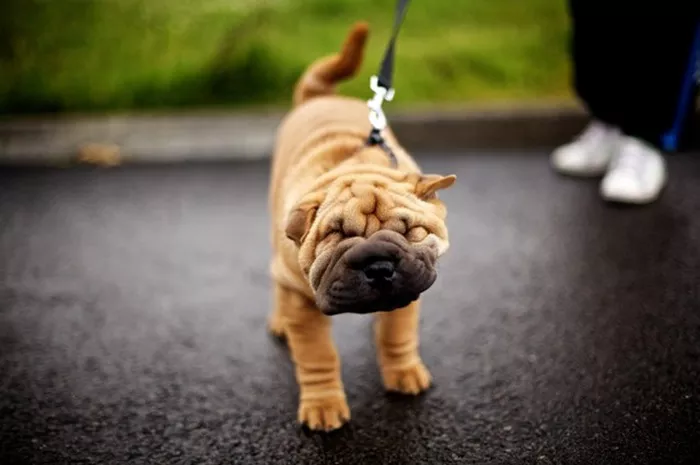Shar Peis are one of the most distinctive dog breeds, known for their deep wrinkles and loyal nature. However, their unique appearance comes with specific health challenges. If you’re considering bringing a Shar Pei into your home, it’s important to understand their health risks, common conditions, and how to care for them properly. This article will provide a detailed look at Shar Pei health, covering genetics, common diseases, and tips for keeping them in good shape.
The Genetic Background of Shar Peis
Shar Peis originated in China, where they were bred for guarding, hunting, and even fighting. Their loose, wrinkled skin was initially a defense mechanism—it made it harder for opponents to grab them. However, selective breeding for exaggerated wrinkles has led to several health problems.
One key issue is a genetic mutation affecting hyaluronan, a substance that gives their skin its unique texture. While this mutation creates their signature look, it also increases the risk of skin infections and a serious condition called Shar Pei fever. Understanding their genetics helps explain why they face certain health challenges more than other breeds.
Common Health Problems in Shar Peis
Skin and Wrinkle Infections
Shar Peis are prone to skin issues because their deep folds trap moisture, bacteria, and yeast. Without proper cleaning, these wrinkles can become irritated and infected. Regular grooming is essential—owners must clean between the folds to prevent dermatitis. Using medicated wipes or gentle cleansers can help keep their skin healthy.
Shar Pei Fever (Familial Shar Pei Fever)
This is a hereditary condition causing recurrent fever, joint swelling, and pain. In severe cases, it can lead to amyloidosis, a life-threatening disease where abnormal proteins damage organs. There is no cure, but early detection and anti-inflammatory medications can manage symptoms. Responsible breeders test for this condition to reduce its spread.
Eye Problems: Entropion and Glaucoma
Shar Peis often suffer from entropion, where eyelids roll inward, irritating the cornea. If untreated, it can cause ulcers or blindness. Many Shar Peis need surgical correction. They are also at higher risk for glaucoma, a painful eye disease that increases eye pressure. Regular vet check-ups are crucial to catch these issues early.
Hip Dysplasia and Joint Issues
Like many medium-sized breeds, Shar Peis can develop hip dysplasia, a malformation of the hip joint leading to arthritis. Maintaining a healthy weight and providing joint supplements can help. Low-impact exercise, like swimming, is better than high-impact activities that strain their joints.
Ear Infections
Their small, folded ears restrict airflow, making them prone to infections. Weekly ear cleaning with a vet-approved solution can prevent buildup of wax and bacteria. Signs of infection include redness, odor, or excessive scratching.
How to Keep Your Shar Pei Healthy
Proper Diet and Weight Management
Obesity worsens joint and skin problems. Feed your Shar Pei high-quality dog food with balanced nutrients. Avoid overfeeding and limit treats. Some Shar Peis have food allergies, so grain-free or hypoallergenic diets may be necessary.
Regular Grooming and Skin Care
Clean their wrinkles daily with a damp cloth and dry thoroughly. Bathe them monthly with a mild shampoo to avoid skin irritation. Check for redness or sores between folds. Brush their coat weekly to remove loose hair and distribute natural oils.
Routine Veterinary Visits
Annual check-ups help detect problems early. Blood tests can monitor for amyloidosis, and eye exams can catch entropion or glaucoma before they worsen. Vaccinations and parasite prevention are also vital.
Moderate Exercise
Shar Peis don’t need intense workouts—short walks and play sessions are enough. Avoid overheating, as their short noses make them prone to breathing difficulties in hot weather.
Choosing a Healthy Shar Pei Puppy
If you’re getting a Shar Pei puppy, select a reputable breeder who tests for genetic conditions. Ask for health clearances on the parents, including screenings for hip dysplasia, Shar Pei fever, and eye diseases. A well-bred puppy has fewer wrinkles, reducing future skin issues.
Adopting an adult Shar Pei? Request medical records and have a vet examine them for existing conditions. Rescue organizations often provide health assessments before adoption.
Conclusion
Shar Peis are loving and protective companions, but their health needs require commitment. Their wrinkles, while adorable, demand daily care to prevent infections. Genetic conditions like Shar Pei fever and entropion mean potential vet expenses. However, with proper care, regular grooming, and a watchful eye on their health, Shar Peis can live happy, fulfilling lives.
Related topics:
How Much Does a Shar Pei Puppy Cost?
Why Are Shar Peis So Aggressive?


